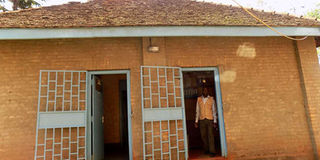Embu building in which Mau Mau were tried

The former colonial court in Embu County that now houses offices. PHOTO | GEORGE MUNENE | NATION MEDIA GROUP
What you need to know:
- The government has preserved the building as a national monument to commemorate the struggle for independence.
More than 70 years ago, a building was put up by the colonial government.
Today, this old, fascinating building, which is located in the Eastern regional headquarters in Embu Town, serves as a bitter reminder of how Kenyans were subjected to all manner of mistreatment by the colonialists.
This is the African court where all those who rebelled against the colonial government, particularly the Mau Mau freedom fighters, were tried and convicted.
The court was established to tame rebellious locals who felt that their rights were being violated.
They insisted that the colonialists were oppressors and wanted to be left alone to govern themselves.
Through these courts, the colonial masters were able to rule Africans as well as carry out their activities without much interference.
TORTURE
Such courts were built in urban centres. Many Africans were convicted on trumped-up charges, making the courts unpopular with Africans.
During the struggle for independence, the freedom fighters were captured, tortured and brought before court to face various criminal charges. Some of them succumbed to their injuries while in jail.
Other suspects were hurriedly tried without being given an opportunity to defend themselves and condemned to death.
A hero in the fight for self-rule, the late General Kassam Njogu, was one of the victims of torture. The colonial soldiers cut off one of his legs with a chainsaw.
General Kassam was hospitalised for months and, even before recovering, was tried in this very court. After being found guilty, he was thrown into Manyani, the dreaded detention camp where he languished for years.
DETENTION CAMPS
Though General Kassam spent most of his youthful years in detention, he was one of the few who made it out alive and returned to his family at Kariru village in Kirinyaga County.
Though he died a pauper, the county government has honoured him by naming Kianyaga stadium after him.
Mzee Evans Mwangi, 90, recollects how the freedom fighters were poorly fed in detention camps. “There was no justice at all for war heroes. Some of us were lucky to come out of jail alive. We were treated like slaves or criminals in our own land.”
“It was a terrible experience that will linger in my mind forever,” Mr Mwangi recalled.
A clerical officer, Mr Mark Mbogo, who has worked with the provincial administration for 34 years, says that the court was established in 1940s.
“It is an old building but it was well-built. It was a terrible experience for Mau Mau war heroes, some of whom are still alive,” Mr Mbogo said.
MONUMENT
The building is no longer used as a court but the government has preserved it as a national monument to commemorate the struggle for independence.
It has since been renovated, attracting visitors from far and wide. It houses the Women Enterprise Fund and a section is used as a storage facility for education records and motor vehicle spare parts.
"The building has been partitioned and is being used by two government departments for various functions. The architectural work was excellent and building is serving us well," says Mr Jeremy Nyagah, County Executive Committee member in charge of education.
Is there a site you want us to feature? Write an e-mail to [email protected]





